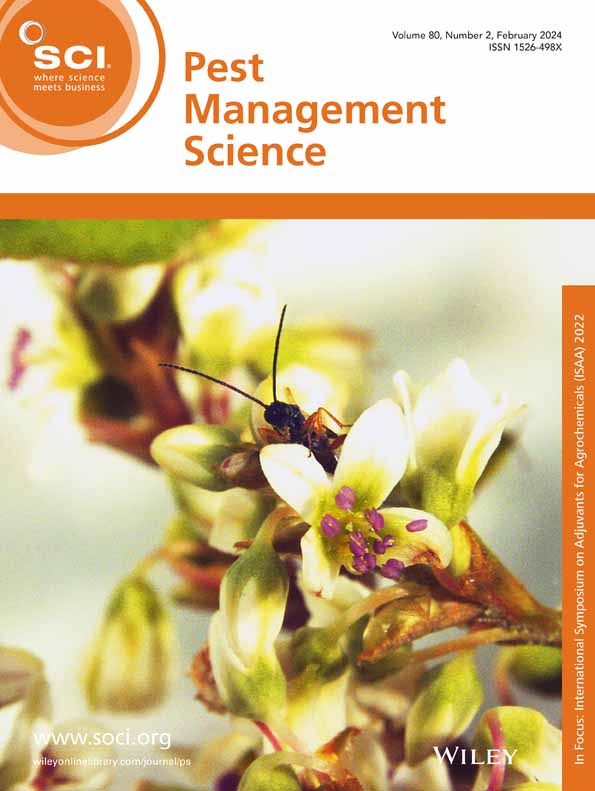Rapid adaptive response of population fitness of Zeugodacus tau during host shifts and implications for integrated pest management strategies.
IF 3.8
1区 农林科学
Q1 AGRONOMY
引用次数: 0
Abstract
BACKGROUND The polyphagous fruit fly Zeugodacus tau Walker (Diptera: Tephritidae) poses significant phytosanitary threats to tropical agroecosystems because of its broad host range and adaptive plasticity. Understanding the mechanisms underlying its rapid host adaptation is critical for developing sustainable integrated pest management (IPM) strategies. METHODS We used age-stage, two-sex life table analyses coupled with untargeted metabolomics to systematically evaluate the effects of host shifts among three key host plants-luffa (Cucurbitaceae; Luffa acutangula), mango (Anacardiaceae; Mangifera indica), and bitter gourd (Cucurbitaceae; Momordica charantia)-on the developmental fitness and metabolic shifts of Z. tau. RESULTS Zeugodacus tau exhibited a distinct intrinsic rate of increase (r), with L. acutangula being the most favored host (r = 0.0914 ± 0.0038), followed by Momordica charantia (0.0785 ± 0.0011) and Mangifera indica (0.0685 ± 0.0038). Remarkably, host-shifted populations achieved demographic stability within two generations, accompanied by rapid recovery of fecundity and host-specific metabolic adjustments, particularly in energy-related pathways (e.g., amino acid metabolic pathways). CONCLUSION This study identifies Z. tau as an invasive pest with exceptional adaptive capacity driven by metabolic plasticity. Our findings underscore the necessity of incorporating host plant rotation and resistant cultivar deployment in IPM frameworks to disrupt its adaptive cycles. © 2025 The Author(s). Pest Management Science published by John Wiley & Sons Ltd on behalf of Society of Chemical Industry.寄主迁移过程中刺鱼种群适应性的快速响应及其对害虫综合治理策略的启示
摘要多食果蝇(双翅目:蝗科)寄主范围广,适应性强,对热带农业生态系统构成严重的植物检疫威胁。了解其快速适应宿主的机制对于制定可持续的害虫综合治理(IPM)战略至关重要。方法采用年龄分期、两性生命表分析结合非靶向代谢组学方法,系统评价3种主要寄主植物丝瓜(葫芦科);丝瓜,芒果(丝瓜科;芒果(Mangifera indica)和苦瓜(葫芦科;苦瓜(Momordica charantia)——Z. tau的发育适合度和代谢变化。结果猕猴桃(zeugodacus tau)表现出明显的内在增长率(r),以针尖菇(L. acutangula)为最优(r = 0.0914±0.0038),其次是苦瓜(Momordica charantia)(0.0785±0.0011)和芒果(Mangifera indica)(0.0685±0.0038)。值得注意的是,宿主转移的种群在两代内实现了人口稳定,伴随着繁殖力的迅速恢复和宿主特有的代谢调整,特别是在与能量相关的途径(例如氨基酸代谢途径)中。结论该研究确定Z. tau是一种具有代谢可塑性驱动的特殊适应能力的入侵害虫。我们的研究结果强调了在IPM框架中纳入寄主植物轮作和抗性品种部署以破坏其适应周期的必要性。©2025作者。由John Wiley & Sons Ltd代表化学工业协会出版的《害虫管理科学》。
本文章由计算机程序翻译,如有差异,请以英文原文为准。
求助全文
约1分钟内获得全文
求助全文
来源期刊

Pest Management Science
农林科学-昆虫学
CiteScore
7.90
自引率
9.80%
发文量
553
审稿时长
4.8 months
期刊介绍:
Pest Management Science is the international journal of research and development in crop protection and pest control. Since its launch in 1970, the journal has become the premier forum for papers on the discovery, application, and impact on the environment of products and strategies designed for pest management.
Published for SCI by John Wiley & Sons Ltd.
 求助内容:
求助内容: 应助结果提醒方式:
应助结果提醒方式:


